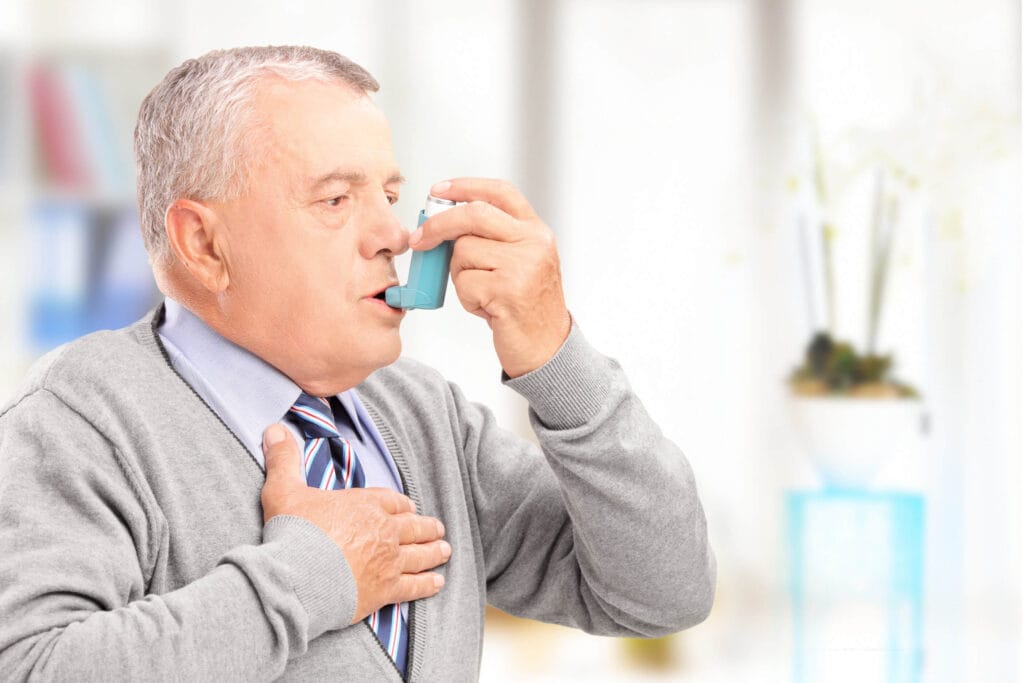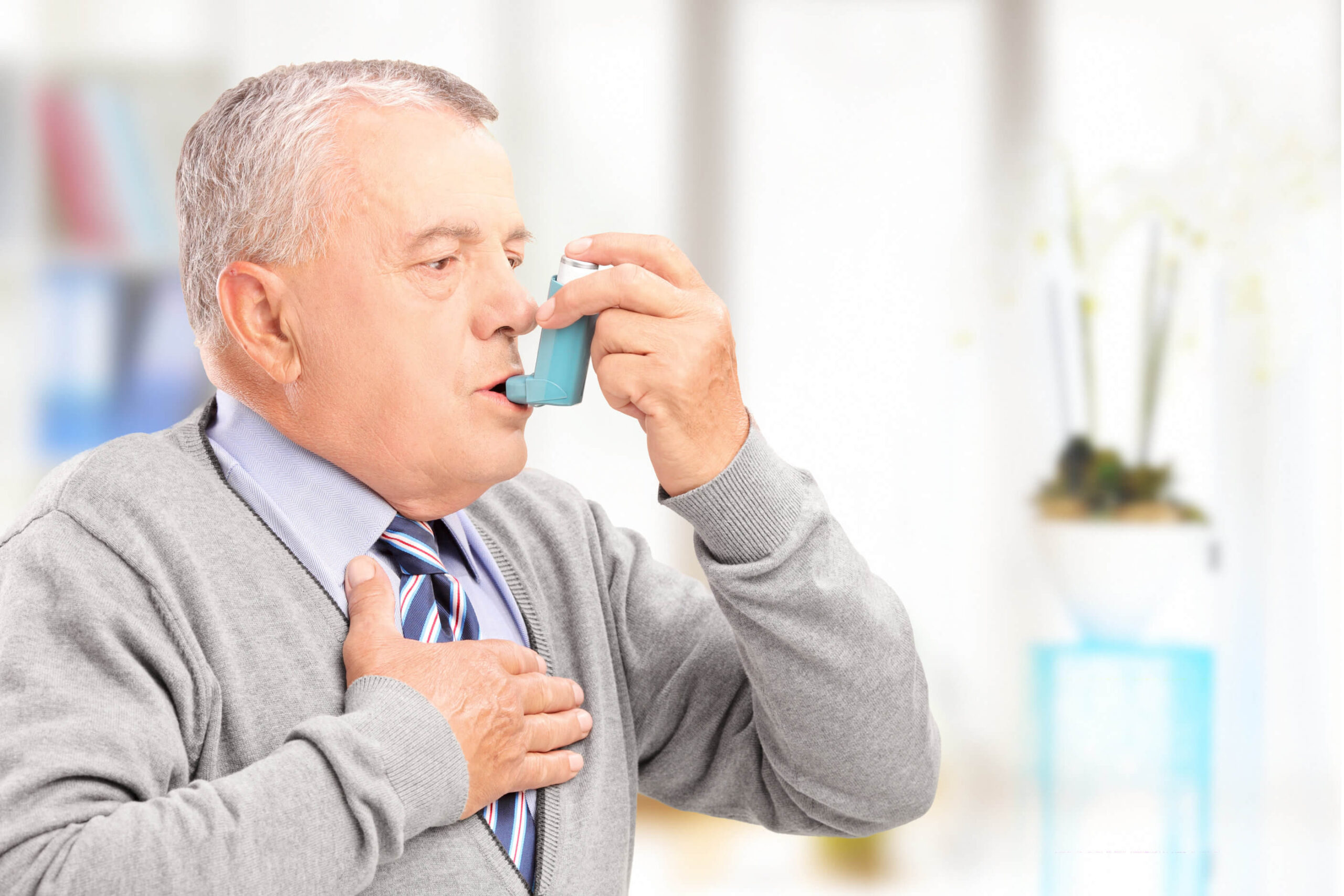Shortness of breath (dyspnea) is a disorder of external respiratory function, accompanied by both objective symptoms and subjective feeling of lack of air. The development of dyspnea is caused by abnormalities of the respiratory and cardiovascular systems, anemia. The symptom can occur due to organic lesions of the CNS, neurotic disorders, metabolic disorders. To identify the cause of dyspnea, spirometry, X-rays, ECG, ultrasound, laboratory tests are performed. Non-pharmacological methods are used to reduce symptoms, correction of the underlying disease is carried out.
General Characteristics
Dyspnea is perceived by patients as a subjective feeling of lack of air, inefficiency of respiratory movements, tightness in the chest. The symptom is accompanied by characteristic objective signs: rapid or slowed inhalations and exhalations, pale or cyanotic nasolabial triangle, convulsive loud inhalation, choking. Often, to relieve the condition, a person with dyspnea stops moving, takes a forced position – sits on a chair or bed, leans slightly forward, leaning on straight arms.
Most often the appearance of dyspnea is associated with physical exertion, and at the beginning of the disease the disorder is provoked only by significant activity, and with progression the patients feel shortness of breath after normal activities. In addition to respiratory disorders, pathological symptomatology is possible: pain and discomfort in the chest, headache, dizziness, reduced performance. If dyspnea is noted when performing the usual work or at rest, it is necessary to consult a specialist.
Mechanism of development
Dyspnea is caused by a variety of complex reflex mechanisms running with the involvement of higher nervous structures, so there are several theories of its development. The direct cause of disturbances in respiratory frequency and quality is considered by many doctors to be a change in the content of oxygen and carbon dioxide in the blood. Increased concentration of carbon dioxide, leading to a decrease in pH, has a significant stimulating effect on the bulbar centers, peripheral chemoreceptor arterial areas and central receptors located in the area of the medulla oblongata.
This activates protective mechanisms, the respiratory center of the brainstem sends activating impulses to the bronchopulmonary system, causing abnormal increased breathing. The emergence of dyspnea is associated with impulses from the spindle-shaped nerve endings of the airways, activated due to various pathological processes. Sometimes increased work of the respiratory center is observed under descending cortical influences caused by hysterical or neurotic conditions.
The connection of the symptom with the temperature of the internal environment of the body has been proved. In hyperthermia, the sensitive areas of the respiratory center are washed by warmer blood, which causes their activation – the so-called thermal dyspnea occurs. A decrease in body temperature, on the contrary, leads to a decrease in respiratory movements. The development of dyspnea is influenced by the magnitude of muscular load and metabolic level. Most researchers believe that this mechanism is caused by two types of reactions – slow humoral and fast neurogenic.
Subjective sensations in the form of shortness of breath and suffocation are primarily associated with the spread of excessive excitation from the centers of the medulla oblongata to the limbic structures and the cortex of the large hemispheres. This causes the appearance of negative emotional reactions of fear and anxiety in patients with dyspnea. Sometimes unpleasant symptoms develop because of a mismatch between the body’s needs for ventilation and the functional capacity of the respiratory apparatus to provide it.

Classification
Dyspnea can manifest itself in many diseases and pathological conditions, so to facilitate the diagnostic search, it is necessary to accurately determine its type. Classification of the symptom is based on the mechanism of development, the degree of change in respiratory function, the ratio of the phases of inspiration and exhalation. A distinction is made between physiological dyspnea, when the frequency of breaths and exhalations changes in proportion to physical load, and pathological. The symptom is most often classified in relation to the respiratory phases:
Inspiratory dyspnea. This type of disturbance is manifested by a predominant difficulty in the inhalation phase. Dyspnea is detected in diseases of the diaphragm and pleura, heart failure, pulmonary fibrosis. Dyspnea combined with noisy breathing is characteristic of pathologies of the trachea, large bronchi.
Expiratory dyspnea. The symptom is usually observed in violation of the patency of the small bronchi and bronchioles, typical for bronchial asthma. Dyspnea on exhalation also occurs with chronic obstructive bronchitis, pneumosclerosis, decrease in elasticity of lung tissue as a result of emphysema.
Mixed dyspnea. Respiratory impairment in both phases often develops with a severe stage of heart failure, progressive diseases of the respiratory system. This type of dyspnea can be associated with febrile states, CNS pathologies with direct irritation of the respiratory center.
Given the changes in respiratory function, there are several types of dyspnea: tachypnea – increased rate of breaths over 40 per minute, bradypnea – reduced respiratory movements of less than 12 per minute, apnea – abrupt respiratory arrest. There is a classification of the symptom according to the basic mechanism of development: central dyspnea is observed with organic or functional changes in the respiratory center in the medulla oblongata, the neurogenic variant is associated with a weakening of the inhibitory effects in the cerebral cortex, a hemic form develops with anemia.
Causes of dyspnea
Causes of shortness of breath
Subjective feeling of difficulty in breathing can be observed in healthy people after intense physical activity, in pregnant women. Pathological causes of the symptom are various disorders in the respiratory and other systems of the body. Shortness of breath is caused by:
Lung diseases: kruposny and interstitial pneumonias, tuberculosis, sclerotic processes and primary amyloidosis.
Pleurisy: dry, exudative, hemorrhagic.
Respiratory tract injuries: foreign bodies of the trachea, bronchi, thoracic trauma, pulmonary bleeding.
Laryngeal causes: false croup, laryngomalacia, neuropathic paresis.
Tumors: pleural cancer, bronchioloalveolar cancer, invasive thyroid cancer.
Acute conditions: cardiac asthma with heart attacks, heart defects, pulmonary embolism.
Neuroses: panic attacks, vegetovascular dystonia, cardioneurosis.
Causes of difficulty exhaling
Expiratory dyspnea with cramped short breaths and prolonged exhalation often serves as a sign of various diseases of the bronchopulmonary system. The symptom is often accompanied by a feeling of tightness in the chest. Difficulty in exhalation is manifested by the following pathological conditions:
Bronchial asthma: allergic, mixed, occupational.
Obstructive defeat of the airways: bronchitis and COPD, bronchiectatic disease, stenoses of the trachea and bronchi.
Pulmonary pathology: pneumosclerosis, emphysema, alpha1-antitrypsin enzyme deficiency.
Occupational diseases: bissinosis, gasoline pneumonia.
Complications of pharmacotherapy: administration of NSAIDs (especially aspirin), infusion of blood or plasma high in citrate.
Rare causes: Williams-Campbell syndrome, Mendelsohn syndrome, tumors in tracheal bifurcation area.
Diagnosis
Patients with complaints of shortness of breath or difficulty in exhalation seek help from a pulmonologist or district therapist. The diagnostic search involves laboratory and instrumental studies of the respiratory system, functional tests. The most informative to clarify the cause of dyspnea are:
Assessment of external respiration. Spirometry is a noninvasive and accessible method of research, during which the main parameters of the respiratory system are recorded – vital capacity of the lungs, volume of forced exhalation for the first second. To differentiate between COPD and asthma, a bronchodilation test is indicated.
Radiological examination. Chest radiography in 2 projections allows to detect typical pathological changes (diffuse sclerosis, emphysema, volumetric masses), in which dyspnea usually occurs. Further examination involves the use of computed tomography, MRI.
Laryngoscopy. To detect narrowing of the laryngeal lumen, visualization of foreign bodies, mucous membranes are examined with a special laryngoscope. If there are no signs of lesions, laryngoscopy is supplemented by tracheobronchoscopy for a detailed study of the structure of the bronchial tree with collection of material for cytomorphological examination.
Electrocardiography. ECG is performed to rule out cardiologic causes of dyspnea. If the results are doubtful, the cardiovascular system is examined in an extended format: phonocardiography, ultrasound of the heart with dopplerography are prescribed. In case of probable periodic disorders, Holter monitoring is applied.
Laboratory tests. Assessment of blood oxygen saturation and carbon dioxide levels is necessary to determine the degree of respiratory disorders. In the general blood test, there may be signs of inflammatory processes (increased sedimentation rate, leukocytosis). Biochemical blood tests are also recommended.
To identify the etiological factor of dyspnea, allergy tests are performed, the results of extended immunogram are informative. If suspicious masses are detected on radiographs, transbronchial lung biopsy is performed. To diagnose rare congenital malformations as a possible cause of dyspnea, specialized specialists are involved.

Treatment
Help before diagnosis
At the onset of an acute attack of dyspnea the patient should be reassured and sit down on a chair or bed with the trunk in an elevated position. To relieve breathing, it is advisable to remove tight clothing, belt, unbuckle the collar of the shirt. It is necessary to ensure the flow of fresh air into the room – open a window or door. Allowed to take herbal sedatives. Frequent occurrence of breathing difficulties indicates the development of disease or progression of pre-existing disease. In such a situation it is necessary to see a doctor as soon as possible.
Conservative therapy
The scheme of treatment is chosen individually, taking into account the cause of dyspnea. An important place in the treatment of chronic conditions, accompanied by shortness of breath, is taken by lifestyle correction: refusal to smoke, regular performance of a special set of exercises. If hypoxemia occurs, oxygen therapy sessions are carried out. Etiotropic, pathogenetic and symptomatic drug therapy with drugs of the following groups is indicated:
Bronchodilators. Short-acting beta-adrenomimetics in the form of inhalers are used for rapid relief of dyspnea attacks. Long-acting β2-agonists, methylxanthines are used as baseline therapy.
Expectorants. Medications are effective in chronic bronchitis, COPD. They stimulate the expectoration of sputum, improve the patency of the bronchial tree. In some cases, drugs for expectoration are combined with mucolytics.
Antibiotics. Antimicrobial agents are prescribed for acute and chronic inflammatory lesions of the airways, caused by bacterial microflora. When choosing an antibacterial drug, the results of sputum culture are taken into account.
Cardiotonics. To reduce dyspnea in patients suffering from heart disease, cardiac glycosides are used. Pre- and postload on the myocardium is reduced with peripheral vasodilators and diuretics.
Corticosteroids. In severe respiratory distress, hormonal drugs are indicated on a continuous basis. In patients with bronchial asthma, inhaled forms of glucocorticoid hormones are effective.
Cytostatics. Courses of chemotherapy with antitumor drugs are recommended for patients with malignant neoplasms of the lungs and bronchi. To enhance the effect, drug treatment is supplemented with radiation therapy.




